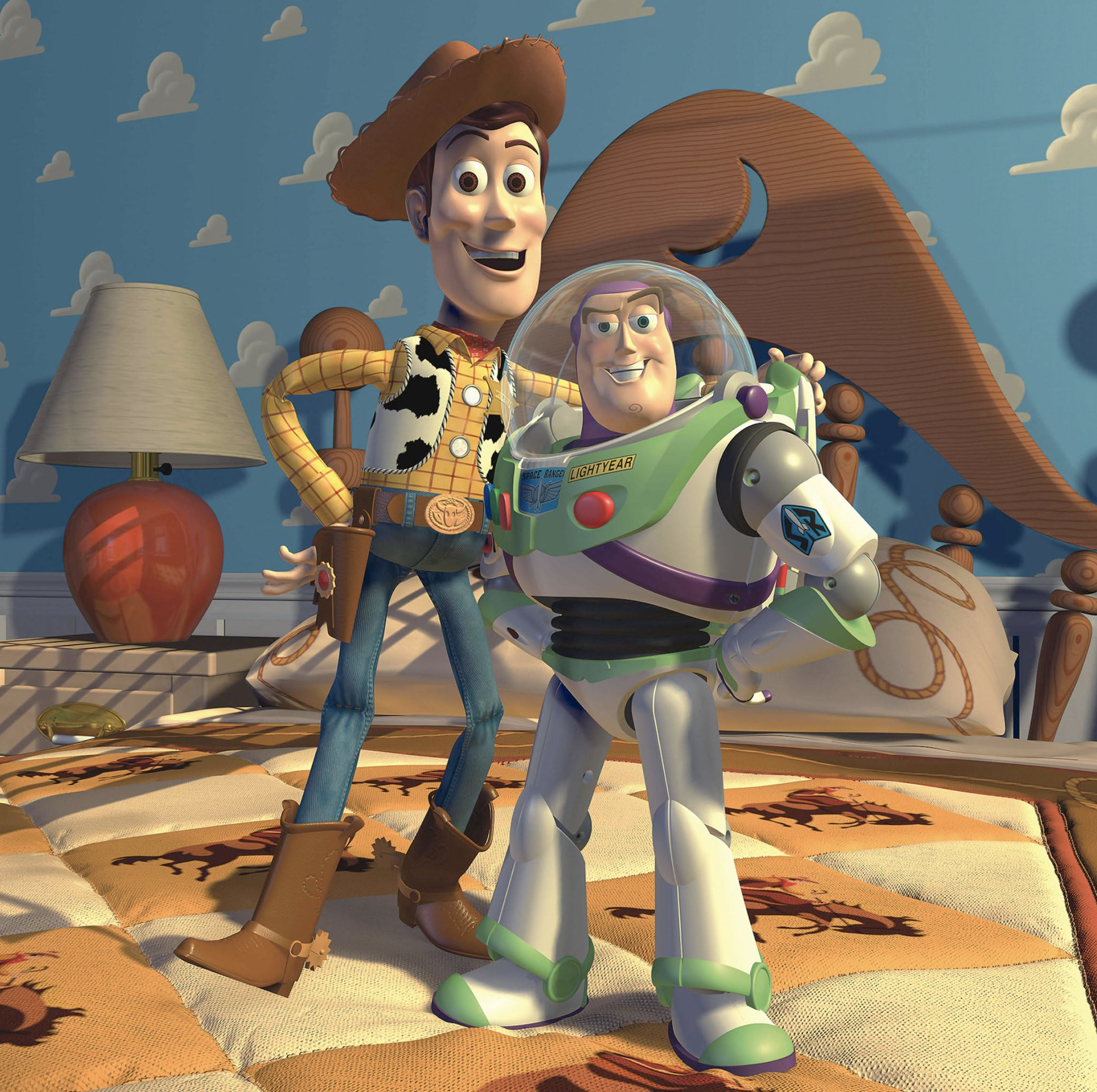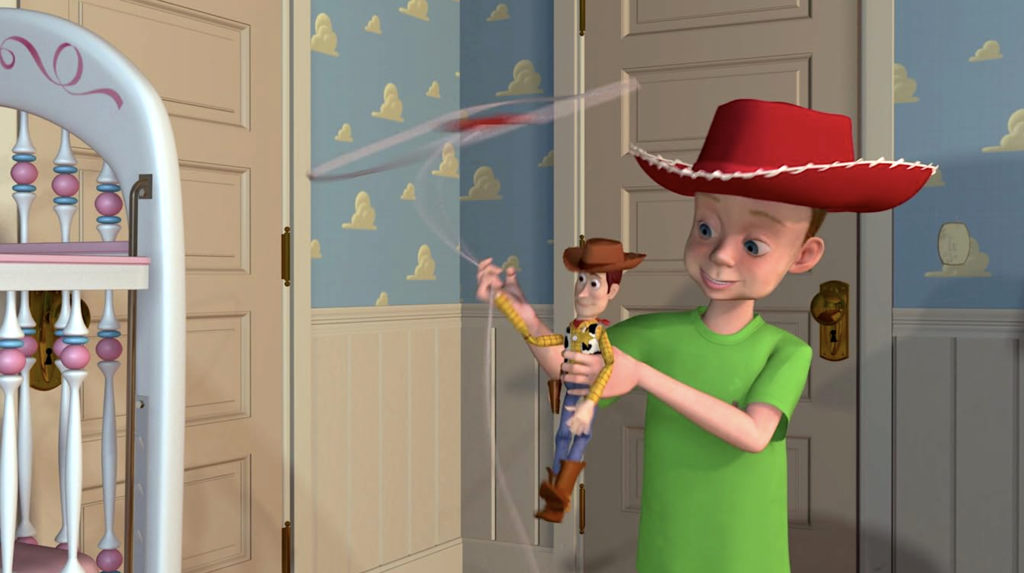This year marks the 30th anniversary of Pixar’s “Toy Story,” which is commemorating the occasion by re-releasing the film to theaters. Through some cosmic coincidence it also marks the 30th anniversary of myself, two titans emerging from that otherwise dull stretch called 1995 (albeit in the shadow of the Macarena).
“Toy Story” was the first entirely computer-animated film, and its revolutionary success allowed Pixar to create, in the parlance of its Disney taskmasters, a whole new world. It was the world I grew up in, so in describing its impact I am very much a fish debating the merits of water.
“Toy Story,” as if the basic beats haven’t been drilled into your head from repeat viewings, imagines a world where all toys are sentient and moving about when their owners aren’t looking. This alone caused something of a crisis in my generation, with many of us convinced our playthings were ensouled and instilling a guilty paternalism to Taiwanese plastic. My dad likes to recount the time he tried to toss away a broken Happy Meal toy and I treated it with all the gravity of manslaughter.
Woody (Tom Hanks) is Andy’s favorite toy and de facto leader of the rest, but is suddenly cast aside as the newer, flashier Buzz Lightyear (Tim Allen) steals Andy’s attention. Even more aggravating is how Buzz, fresh from the packaging, doesn’t appreciate his position as favored toy, still convinced he’s a bonafide space ranger. The film isn’t subtle in its imagery, with its old hand cowboy at odds with the chrome spaceman. “Toy Story” is a movie at a precipice about that precipice, a generational transition where the old has to make peace with change, while the new learns to incorporate itself into a tradition.
It is the faultline through the soul of Pixar itself. Its artists were inspired by the traditional, 2D hand-drawn animation that came before, while wanting to push the artform forward with a new digital technique.
As the first of its kind, there are some noticeable but forgivable growing pains. It’s saying a lot that in a movie featuring mutant toys constructed by a burgeoning child Mengele, the most grotesque sight is any of the human characters, with their vacant eyes and noneuclidian brows. The rest of the animation holds up marvelously, some sequences looking better than what Dreamworks offered up even a decade later.
If anything, they were too successful. “Toy Story” first tolled the death knell for noncomputer animation, as audiences were too dazzled by the novelty and voted with their wallets. In the following years, computer animation trounced hand-drawn animation at the box office. What was intended as an option became the menu, with the studios axing animation in the traditional forms. Contrary to the message of the film, the future was not Buzz and Woody finding common ground, but rather Buzz’s marker-signed spaceboot stomping on Woody’s face, forever.

Marshall McLuhan famously said the medium is the message. But revisiting “Toy Story” 30 years later, it remains endearingly old-fashioned in its content. For one thing, it was nice to be reminded of a time when children actually played with toys. If “Toy Story” instilled a pathological attachment disorder in its immediate wake, the next generation of parents solved that by switching almost entirely to tablets. I’m not exactly a Luddite, as my screentime notifications remind me at humiliating intervals, but I can’t help but regard toddlers on iPads as the horsemen of an encroaching apocalypse. I still remember the chill I felt down my spine upon seeing a baby reach out to a picture book and attempt to pinch magnify Peppa Pig.
There is a minute philosophical distinction between toys and computer-based entertainment, but as with most things, therein lies the fate of the species. Toys are a starting point, a cast of characters from where your imagination is the driver.
Growing up, I had an ongoing storyline with my action figures that was conveniently too complicated to explain to siblings who wanted to join in. It was Wagnerian in its intricacy, perhaps even approaching “Days of our Lives” levels. Toys are open runways for the imagination, only as fun as what you bring to the table.
Tablets, on the other hand, are created with clear intention. Each game has a destination, each app a clear intention. These are cordoned off avenues of playtime, a car on a track with the illusion of free movement. “Toy Story” understood that the world rests on a child combing worlds haphazardly, a Batman figure defeating a dinosaur to rescue a Barbie doll twice his size. Freudian ramifications aside, it’s vital for kids to learn to literally play by their own rules, lest they be bound to a compartmentalized world they hate but lack the capacity to fix.
“Toy Story” is also refreshingly down-to-earth in its messaging. Most children’s animation these days follows an odd conformity, often about generational trauma and how parents need to adapt and listen. You can trace the genesis to here: Woody rejects any change to the status quo that would diminish his position (and the wind whispers “Boomer”). But Woody has some hard-fought wisdom of his own, and it’s this perspective that helps Buzz get out of his existential funk.
Buzz is so insecure in his position that he’d rather suffer delusions of grandeur than face the hard truth of his own insignificance. He can’t merely be a Buzz Lightyear, he needs to be the Buzz Lightyear. While Woody bases his self-esteem on his hierarchy among the toys and his favored relationship to Andy, Buzz needs to transcend the whole enterprise. Only old school Woody can teach Buzz the value in being ordinary and fulfilling your purpose, but then it takes the next generation to remind Woody just what that purpose was.
That next sound you hear is the 2,000-year echo of Jesus bonking together the heads of his disciples. Why are you wasting time arguing who is the greatest? Your job is service, as the zen koan tells us, to infinity and beyond.

